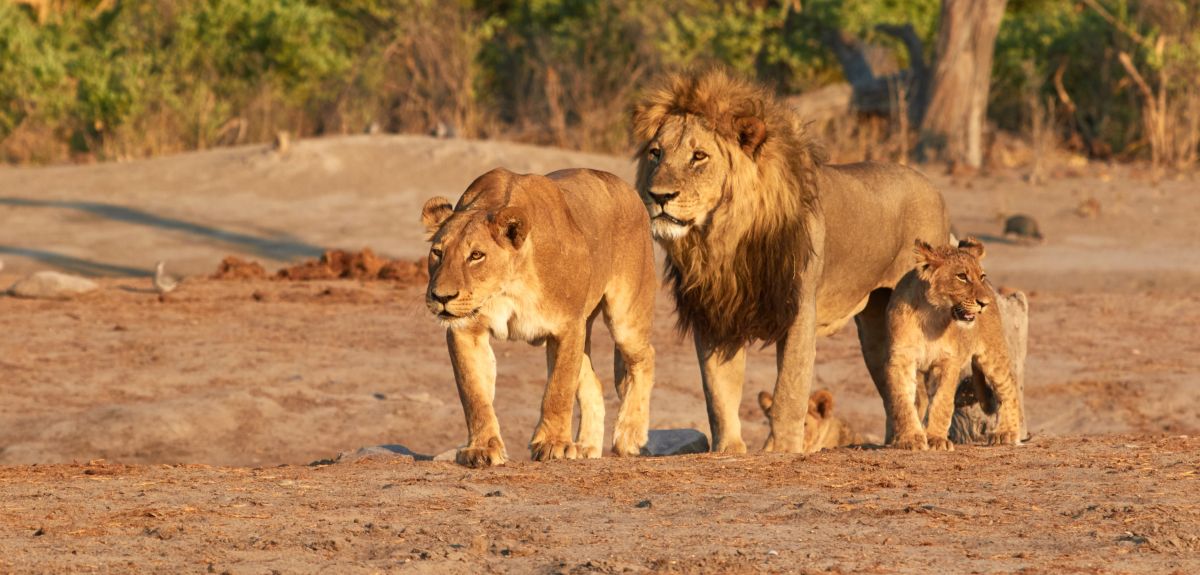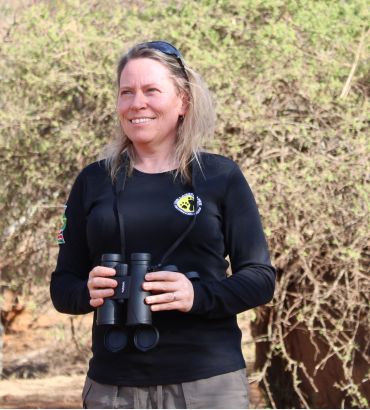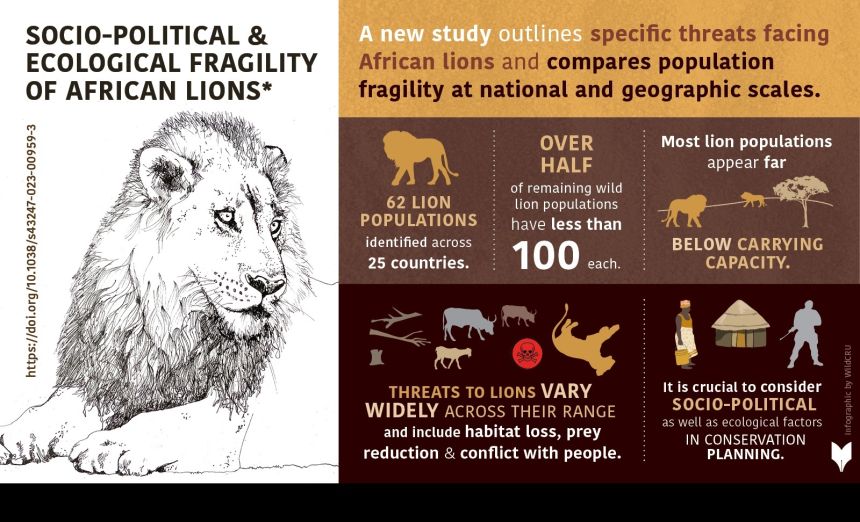
Lions on the brink – New analysis reveals the differing threats to African lion populations
New research co-led by Oxford University’s Wildlife Conservation Research Unit (WildCRU) has revealed alarming data about dwindling lion populations in Africa, but gives new insight into conservation strategies. The study, published in the Journal Communications Earth & Environment, provides a framework for evaluating investments into saving lions that considers threats from both ecological and socio-political factors.
 Professor Amy Dickman. Credit: Lion Landscapes
Professor Amy Dickman. Credit: Lion LandscapesThe study built on extensive lion monitoring projects which WildCRU has played a major role in for decades to map the current state of lion populations across Africa. This revealed that whilst the total population of wild lions in Africa may be estimated at between 20,000 and 25,000 individuals, many of these live within small, fragmented populations at risk of disappearing. For instance, of the 25 countries where African lions remain, nearly half of these nations have fewer than 250 individuals, with eight countries having only a single wild lion population. Furthermore, less than half of the 62 known wild African lion populations have over 100 lions.
However, the vulnerability of different lion populations cannot be assessed simply through their size. For each population, the researchers identified ecological and socio-political factors that may influence their survival. Smaller lion populations or higher densities of people and livestock, for example, would contribute to higher ecological fragility, while higher levels of corruption or lower GDP per capita would contribute to greater socio-political fragility. These were then integrated into a single overall fragility index, and each lion population was compared relative to the others.
The combination of these two indices provided some interesting comparisons. For instance, both Sudan and Benin have a single known lion population with roughly the same number of lions. However, whilst Benin is relatively more stable and prosperous, Sudan is currently involved in a civil war with people fleeing in the millions. The war and instability undercut the ability of park rangers or others to help ensure the continuation of Sudan’s lions.
 A summary of the findings from the new analysis. Credit: Sarah Markes, WildCRU.
A summary of the findings from the new analysis. Credit: Sarah Markes, WildCRU.Whilst the fragility score does not suggest which lion populations deserve protection or funding, it can help to highlight the varying ecological and anthropogenic pressures facing different populations and which populations may require relatively more resources to conserve.
Professor Dickman said: ‘Some populations may ultimately have similar fragility scores, but they are driven by different threats. Thus, while on the surface, the lone lion populations in Sudan and Benin may appear similar, they likely require different levels of investment and perhaps even different types of intervention for conservation to succeed. Pouring money into conserving Sudan’s lions may be relatively ineffective unless the socio-political factors such as the civil war are dealt with first.’
Maintaining wild lion populations will require sustained effort and significant levels of international investment, particularly as many of the key challenges are likely to only increase. Without such efforts, lion populations will become even more fragile, and we will come substantially closer to losing this most iconic African predator.
Professor Amy Dickman, Wildlife Conservation Research Unit, University of Oxford.
Rapidly growing anthropogenic pressures on natural resources, particularly in Africa, suggest a challenging future for lions, and wildlife in general. With human-induced threats like habitat loss, prey depletion, and human-wildlife conflict, lions are increasingly being pushed to the brink. However, conservation efforts are having some success. For instance, WildCRU has an extensive history of lion conservation work in Africa with several sites (such as the Hwange and Ruaha ecosystems) where long term engagement with conservation authorities and local communities has substantially reduced threats to lions, and improved the conservation outlook for them as well as for other species.
Nevertheless, according to the researchers the new findings underscore the moral responsibility of wealthier nations to contribute more significantly to lion conservation. Almost all of the remaining African lion range is within countries that rank in the 25% poorest countries in the world. This leaves the remaining African lions vulnerable to the pressures felt by many of the poorest countries and communities in the world. The researchers estimate that the costs for protecting all the remaining African lions may be as high as US$3 billion annually.
Professor Dickman added: ‘Conservation science is important to guide action, but this research highlights the invaluable role that politicians, economists, development experts and others must play if we are to safeguard lions and other biodiversity, in ways which also enable rural development rather than stand in its way.’
The study ‘Socio-political and ecological fragility of threatened, free-ranging African lion populations’ has been published in the Journal Communications Earth & Environment. The study was co-led by WildCRU and the Endangered Wildlife Trust.
 Expert Comment: The illegality of the US attack against Venezuela is beyond debate - how the world reacts is critical
Expert Comment: The illegality of the US attack against Venezuela is beyond debate - how the world reacts is critical
 Honorary degree recipients for the Chancellor’s ceremony announced
Honorary degree recipients for the Chancellor’s ceremony announced
 Expert Comment: What US action in Venezuela could unleash — regionally and globally
Expert Comment: What US action in Venezuela could unleash — regionally and globally
 Expert Comment: Why cherish the analogue in a digital age?
Expert Comment: Why cherish the analogue in a digital age?